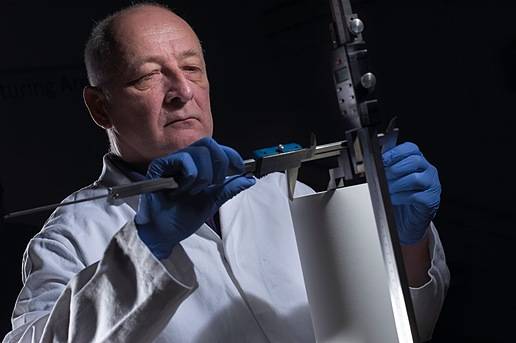 Zircotec 公司排气系统组件的等离子涂层。
Zircotec 公司排气系统组件的等离子涂层。 Zircotec 公司总经理 Terry Graham 表示,为了满足即将到来的新排放标准要求,车辆的尾气温度可能会有升高。
Zircotec 公司总经理 Terry Graham 表示,为了满足即将到来的新排放标准要求,车辆的尾气温度可能会有升高。 Zircotec 涂层组件的质量控制流程。
Zircotec 涂层组件的质量控制流程。
工程师们可能认为,汽车的研发历史已有一个多世纪之久,汽车动力总成中各个部件的热量处理问题一定已经得到了有效解决。但现在限另一个问题又凸显出来——如何保证车辆尾气的温度不高不低,恰好符合人们的要求?这对商用车和非公路设备的影响尤为明显。
如何控制尾气温度?这个新挑战不仅将直接影响车辆的排气系统,而且也与汽车行业老生常谈的几个需求分不开:效率、法规、尺寸、成本。如何在这些相互矛盾的需求之间达到平衡?这是一个问题。
热管理专业技术公司 Zircotec 集团总经理 Terry Graham 警告说,即将实行的全球排放新标准,将给车辆的发动机、催化器和柴油颗粒过滤器 (DPF) 提出新的优化要求,而这均有可能导致车辆尾气温度的升高。
此外,汽车行业还必须面对另一个挑战。Graham 表示,“为了保证涡轮增压器的效率和响应能力,我们还必须将尾气的温度控制在一定水平之上。Zircotec 认为,有时,排气系统的内部温度可能将从 500°C 上升至超过 700°C。在某些情况下,通过加装催化器和过滤系统来优化车辆性能,可能会增加排气系统的尺寸,影响周边其他不耐热的车辆系统,进而给车辆的整体封装带来挑战。”
减少热量传递
Zircotec 公司正在寻找各种可能办法,减低热量在整个排气系统中的传递,包括使用排气歧管以减少高温废气向其他外部系统传递热量的机会,从而维持尾气温度。这种设计可能对车辆的冷启动和系统预热时间产生重大影响,还能降低外壳结构的工作温度。由于对材料的热性能需求更低,因此厂商可以使用一些更加经济的选择。
Graham 说,“即使是用于支撑排气系统的金属夹子,也可能成为热量损失的主要来源之一。为了解决这个问题,Zircotec 与一家供应商合作研发了一种陶瓷涂层解决方案。”
相关安全法规已经对车辆尾气温度进行了限定。然而,除了易燃性外,商用车辆的高温尾气更有可能给行人带来伤害。Graham 认为,目前一些组件的最高外部温度为 480°C (896°F),而未来可能被强制限制到 70°C (158°F) 左右。
“传统的解决方案,是在可能受到影响的区域增加隔热层,但如果使用传统材料,这个隔热层通常必须要 70毫米以上,才能真正实现热阻隔。” Graham 表示,“在许多应用中,除非重新走线,否则排气系统根本腾不出空间安装这种厚度的隔热层。此外,这种做法还有可能引发一系列连锁反应,给车辆的其他系统和整体封装带来影响。当然还会增加成本。”
为了缩短车辆预热的时间,并保证关键系统可以在有需要时得到充足热量,汽车的热管理系统通常需要非常严密的控制。
然而,Graham 估计,目前的设计仅能保证尾气中刚好有足够的热量驱动这些系统,而我们需要开发一种新的方法。他说,“为了保证效率,我们的一个客户希望保证尾气在排气管的温度不低于排出发动机时的 87%。要做到这一点,我们必须仔细分析排气系统中各个部件的热量传递情况。”
后处理系统
为了显著提高尾气净化效率,Zircotec 公司的另一个关注点是后处理系统的热管理性能。Graham 表示,Zircotec的技术可以用于 DPF 和催化器系统的内外表面,从而提高系统内部气体的温度,保证热量可以顺利传递、集中至有需要的地方,并同时通过优化隔热性能,降低传递到系统之外的热量。Zircotec 公司还积极与多家一级供应商客户合作,研发模块化催化器单元的隔热系统,为未来需求做好准备。
为了缩小安装尺寸,Zircotec 公司对 ThermoHold 陶瓷隔热材料的应用进行了大量调查对比,包括采用和不采用整体传统金属隔热屏的情况。通过引入一些小型气隙,此类解决方案可以针对不同工作环境和具体情况进行优化,从而优化隔热性能。
Graham 说,“隔热板可以在密闭空间内提供效果显著的热保护效果,是一种极具性价比的解决方案。”
Graham 补充说,优化排气歧管的热管理性能是公司的长期重点项目之一。为了实现这一目标,公司已经与一家主要汽车制造商和多家尾气处理系统组件供应商展开合作,将通过两种“非常特殊”的手段,验证在歧管内部应用 ThermoHold 陶瓷涂层的效果。
目前,原型开发已经完成,也已经有一家歧管供应商采用了 Zircotec 的陶瓷材料。Graham 表示,根据早期试验和相关的测试结果看来,“前景非常光明”。
Automotive engineers may have thought that after a century or more, the problems of handling heat in all parts of the powertrain had been solved. But another is emerging that particularly affects commercial vehicles (CVs) and off-highway equipment: keeping exhaust heat only where it is wanted.
The new challenge affects exhaust systems and involves a combination of the auto industry’s decades-old conflicting demands: efficiency, legislation, packaging and cost.
Terry Graham, managing director of thermal management specialist Zircotec Group, warns that expected upcoming global emissions standards will require improvements to the engine, catalyst and DPF (diesel particulate filter), each of which is likely to increase exhaust gas temperature.
But there is an added challenge, said Graham: “It’s a desire to keep heat in the exhaust to maintain turbocharger efficiency and response. Zircotec believes that internal temperatures in some cases will rise from 500°C to levels in excess of 700°C. In some instances, obtaining higher performance from catalysts and filters may require an increase in size, putting pressure on overall packaging as hot exhaust system components encroach on other systems that could potentially be vulnerable to heat damage.”
Reducing heat transmission
So Zircotec is now looking at ways of reducing heat transmission throughout the entire structure of the exhaust, including the exhaust manifold, thus reducing heat transfer from the hot exhaust gas to the outer containment to help maintain exhaust gas temperatures. This would also potentially have a significant impact on cold-start and the time taken for systems to warm up. It should also cut the operating temperature of the containment structure, reducing the thermal demands on the material and allowing more economic choices.
“Even the metal clamps holding the exhaust system can be a major source of heat loss. To overcome this, Zircotec is working with a supplier on ceramic coatings options to reduce this effect,” revealed Graham.
Safety legislation already limits external temperatures. Apart from flammability, the exhaust on a CV is more exposed to pedestrians. The maximum external temperature, currently as high as 480°C (896°F) on some components, could be mandated down to just 70°C (158°F), believes Graham.
“The traditional solution would be to add insulation around the affected areas, but conventional materials would typically need to be up to 70 mm thick to achieve the thermal barrier performance required,” he said. “There just isn’t the room for such a thickness in many applications without re-routing the exhaust line and introducing knock-on effects that would compromise other systems and overall packaging, to say nothing of the cost involved.”
On modern vehicles, heat management is often carefully controlled to reduce warm-up times and ensure sufficient heat is delivered to key systems.
But Graham estimates that the point is approaching where there is only just enough high-grade heat in the exhaust gas to drive these systems, so a different approach is required: “For reasons of efficiency, one of our clients is aiming to maintain the exit gas temperature at the tailpipe to no less than 87% of the temperature at which it leaves the engine. To achieve this we have to analyze the heat transmission through each individual component of the exhaust system.”
Aftertreatment considerations
A further key focus for Zircotec is on thermal management of the aftertreatment systems to significantly improve clean-up efficiency. Graham said Zircotec’s technology can be used inside and around the DPF and catalyst to increase the internal gas temperature and ensure heat is delivered and focused where it is needed, yet simultaneously reduce external heat transmission through improved thermal barrier performance. Together with one of its Tier 1 customers, the company is working on the insulation of a modular catalyst unit that would meet future requirements.
To reduce the packaging space required, Zircotec is investigating the use of its ceramic ThermoHold-based heat shield material, both with and without an integral conventional metal heat shield. By incorporating small integral air gaps, solutions have been devised that can operate in different environments and orientations to improve thermal barrier performance.
“The heat shields can deliver significant heat protection within a confined space, providing a highly cost-effective way to meet packaging requirements,” stated Graham.
He added that one of Zircotec’s significant long-term projects is to improve the thermal management of the exhaust manifold. To achieve this, the company has a collaborative program in place with a major vehicle manufacturer, and with exhaust component suppliers, via two “very different” approaches to examine the incorporation of ThermoHold ceramic coating within the manifold.
Prototypes have been produced, with the Zircotec ceramic-based material used and applied by a manifold supplier. Graham says early trials, and associated test results, are “very promising.”
Author: Stuart Birch
Source: SAE Automotive Engineering Magazine
等级
打分
- 2分
- 4分
- 6分
- 8分
- 10分
平均分
- 作者:Stuart Birch
- 行业:汽车
- 主题:动力与推进力
